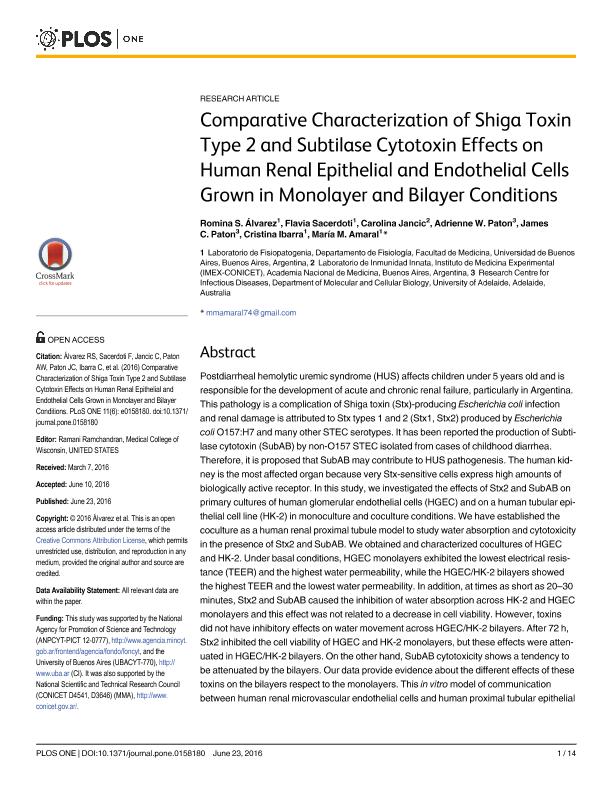Artículo
Comparative Characterization of Shiga Toxin Type 2 and Subtilase Cytotoxin Effects on Human Renal Epithelial and Endothelial Cells Grown in Monolayer and Bilayer Conditions
Alvarez, Romina Soledad ; Sacerdoti, Flavia
; Sacerdoti, Flavia ; Jancic, Carolina Cristina
; Jancic, Carolina Cristina ; Paton, Adrienne W.; Paton, James C.; Ibarra, Cristina Adriana
; Paton, Adrienne W.; Paton, James C.; Ibarra, Cristina Adriana ; Amaral, María Marta
; Amaral, María Marta
 ; Sacerdoti, Flavia
; Sacerdoti, Flavia ; Jancic, Carolina Cristina
; Jancic, Carolina Cristina ; Paton, Adrienne W.; Paton, James C.; Ibarra, Cristina Adriana
; Paton, Adrienne W.; Paton, James C.; Ibarra, Cristina Adriana ; Amaral, María Marta
; Amaral, María Marta
Fecha de publicación:
23/06/2016
Editorial:
Public Library of Science
Revista:
Plos One
e-ISSN:
1932-6203
Idioma:
Inglés
Tipo de recurso:
Artículo publicado
Clasificación temática:
Resumen
Postdiarrheal hemolytic uremic syndrome (HUS) affects children under 5 years old and is responsible for the development of acute and chronic renal failure, particularly in Argentina. This pathology is a complication of Shiga toxin (Stx)-producing Escherichia coli infection and renal damage is attributed to Stx types 1 and 2 (Stx1, Stx2) produced by Escherichia coli O157:H7 and many other STEC serotypes. It has been reported the production of Subtilase cytotoxin (SubAB) by non-O157 STEC isolated from cases of childhood diarrhea. Therefore, it is proposed that SubAB may contribute to HUS pathogenesis. The human kidney is the most affected organ because very Stx-sensitive cells express high amounts of biologically active receptor. In this study, we investigated the effects of Stx2 and SubAB on primary cultures of human glomerular endothelial cells (HGEC) and on a human tubular epithelial cell line (HK-2) in monoculture and coculture conditions. We have established the coculture as a human renal proximal tubule model to study water absorption and cytotoxicity in the presence of Stx2 and SubAB. We obtained and characterized cocultures of HGEC and HK-2. Under basal conditions, HGEC monolayers exhibited the lowest electrical resistance (TEER) and the highest water permeability, while the HGEC/HK-2 bilayers showed the highest TEER and the lowest water permeability. In addition, at times as short as 20–30 minutes, Stx2 and SubAB caused the inhibition of water absorption across HK-2 and HGEC monolayers and this effect was not related to a decrease in cell viability. However, toxins did not have inhibitory effects on water movement across HGEC/HK-2 bilayers. After 72 h, Stx2 inhibited the cell viability of HGEC and HK-2 monolayers, but these effects were attenuated in HGEC/HK-2 bilayers. On the other hand, SubAB cytotoxicity shows a tendency to be attenuated by the bilayers. Our data provide evidence about the different effects of these toxins on the bilayers respect to the monolayers. This in vitro model of communication between human renal microvascular endothelial cells and human proximal tubular epithelial cells is a representative model of the human proximal tubule to study the effects of Stx2 and SubAB related to the development of HUS.
Archivos asociados
Licencia
Identificadores
Colecciones
Articulos(IFIBIO HOUSSAY)
Articulos de INSTITUTO DE FISIOLOGIA Y BIOFISICA BERNARDO HOUSSAY
Articulos de INSTITUTO DE FISIOLOGIA Y BIOFISICA BERNARDO HOUSSAY
Articulos(IMEX)
Articulos de INST.DE MEDICINA EXPERIMENTAL
Articulos de INST.DE MEDICINA EXPERIMENTAL
Citación
Alvarez, Romina Soledad; Sacerdoti, Flavia; Jancic, Carolina Cristina; Paton, Adrienne W.; Paton, James C.; et al.; Comparative Characterization of Shiga Toxin Type 2 and Subtilase Cytotoxin Effects on Human Renal Epithelial and Endothelial Cells Grown in Monolayer and Bilayer Conditions; Public Library of Science; Plos One; 11; 6; 23-6-2016; 1-14; e0158180
Compartir
Altmétricas



